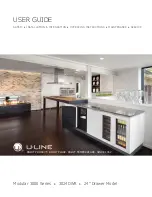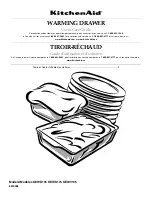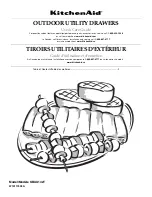
5
U L
Fig.
5-1
Type I Acme thread quick coupler
Pressure
relief
valve
QCC
Type 1
valve
Brass Acme
thread fi tting
Liquid level
indicator
(optional)
Hand nut with Acme
thread
Regulator
Vent
Hose
Hand wheel
The use of pliers or a wrench should not be necessary. Only
cylinders marked “propane” may be used.
To disconnect
: Turn the hand nut counterclockwise until
detached (Fig. 5-1).
Important:
Before
using the unit, and after each time
the cylinder is removed and reattached,
check the hose for wear (see
a
.) and check
all connections for leaks. Turn off the unit
valves and open the main cylinder valve,
then check connections with soapy water.
Repair any leaks before lighting the unit.
CAUTION:
Always turn the propane cylinder main valve
off after each use, and before moving the unit
and cylinder or disconnecting the coupling.
This valve must remain closed and the
cylinder disconnected while the appliance
is not in use, even though the gas fl ow is
stopped by a safety feature when the coupler
is disconnected.
Carefully
inspect the hose assembly each time before the
gas is turned on. A cracked or frayed hose must be replaced
immediately.
If the appliance is stored indoors, the cylinder must be
disconnected and removed. Disconnected cylinders must be
stored outdoors, out of the reach of children, with threaded
valve plugs tightly installed, and must not be stored in a
building, garage, or any other enclosed area.
FOR YOUR SAFETY
a.
DO NOT store a spare propane-gas cylinder under or
near this appliance.
b.
NEVER fi ll the cylinder beyond 80-percent full.
c.
IF THE INFORMATION IN
a.
AND
b.
IS NOT FOLLOWED
EXACTLY, A FIRE CAUSING DEATH OR SERIOUS
INJURY MAY OCCUR.
IMPORTANT FOR YOUR SAFETY
READ AND FOLLOW ALL WARNINGS PROVIDED WITH THE PROPANE-GAS CYLINDER.
When operating this appliance with a propane-gas cylinder, these instructions and warnings
MUST
be observed.
FAILURE TO DO SO MAY RESULT IN A SERIOUS FIRE OR EXPLOSION.
CYLINDER/CONNECTOR REQUIREMENTS
a.
Propane-gas cylinders, valves, and hoses must be
maintained in good condition and must be replaced if
there is visible damage to either the cylinder or valve. If the
hose is cut or shows excessive abrasion or wear, it must
be replaced before using the gas appliance (see
e
.).
b.
This unit, when used with a cylinder, should be connected
to a standard 5-gallon (20 lb.) propane-gas cylinder
equipped with an OPD (Overfi ll Prevention Device).
The OPD has been required on all cylinders sold since
October 1,1998, to prevent overfi lling.
c.
Cylinder dimensions should be approximately 12" (30.5
cm) in diameter and 18" (45.7 cm) high. Cylinders must
be constructed and marked in accordance with the
Specifi cations for Propane Gas Cylinders of the U.S.
Department of Transportation (D.O.T.)
or the National
Standard of Canada,
CAN/CSA-B339, Cylinders,
Spheres, and Tubes for Transportation of Dangerous
Goods.
d.
The cylinder used must include a collar to protect the
cylinder valve, and the cylinder supply system must be
arranged for vapor withdrawal.
e.
The pressure regulator and hose assembly (Fig. 5-1)
supplied
with this outdoor gas appliance (L.P. models
only) must be used. Original and replacement pressure
regulator and hose assemblies must be those specifi ed by
the manufacturer for connection with a cylinder connecting
device identifi ed as Type I by the
ANSI Z 21.58/CGA 1.6
(see PARTS LIST for ordering information).
f.
The propane-gas cylinder valve must be equipped with a
cylinder connection coupling device, described as Type I
in the standard defi ned in paragraph
e
. above. This device
is commonly described as an Acme thread quick coupler.
g.
If the propane-gas cylinder comes with a dust plug, place
the dust cap on the cylinder valve outlet whenever the
cylinder is not in use.
QUICK COUPLER OPERATION
To connect the regulator/hose assembly to the propane-
gas cylinder valve fi tting:
Press the hand nut on the regulator
over the Acme thread fi tting on the cylinder valve. Turn the hand
nut clockwise to engage the threads and tighten until snug.
ENCLOSURE REQUIREMENTS
FOR YOUR SAFETY, you must provide the openings listed below for replacement air and ventilation of the unit enclosure. One
side of the enclosure shall be left completely open to the outside; OR 4 (minimum) ventilation openings MUST be created:
• Each opening must have a minimum of 10 sq. in. of free area. The openings must be equally sized.
• Two openings must be in the side walls of the enclosure, at the top level, and spaced at a minimum of 90 degrees. The openings
must begin 1" or less below the countertop level and end no more than 5" below the countertop level.
• Two openings must be in the side walls of the enclosure, at the fl oor level, and spaced at a minimum of 90 degrees. The openings
must begin 1" or less above the fl oor level and end no more than 5" above the fl oor level.
• The openings must remain unobstructed:
The clearance between the openings and any items outside of the enclosure is
a minimum of 6". The clearance between the openings and any items within the enclosure is a minimum of 2".
It is acceptable to use RHP venting panels (PN 5510-01). Contact your dealer.
KEEP THE REQUIRED VENT OPENINGS AND SURROUNDING AREA OF THE ENCLOSURE CLEAR AND FREE AT ALL TIMES.
WARNING:
Ventilation openings in side walls shall not communicate directly with other enclosures of the outdoor cooking gas appliance.
e.
The pressure regulator and hose assembly used must
match the specifi cation for Type I by
ANSI Z 21.58/CGA
1.6
(see Fig. 5-1).
SAFE USE & MAINTENANCE OF PROPANE GAS CYLINDERS























